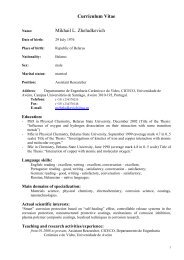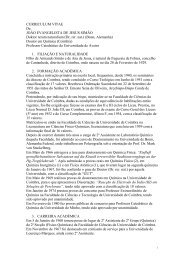XII Iberian Meeting of Electrochemistry XVI Meeting of the ...
XII Iberian Meeting of Electrochemistry XVI Meeting of the ...
XII Iberian Meeting of Electrochemistry XVI Meeting of the ...
Create successful ePaper yourself
Turn your PDF publications into a flip-book with our unique Google optimized e-Paper software.
<strong>XII</strong> <strong>Iberian</strong> <strong>Meeting</strong> <strong>of</strong> <strong>Electrochemistry</strong> & <strong>XVI</strong> <strong>Meeting</strong> <strong>of</strong> <strong>the</strong> Portuguese Electrochemical Society O E 04<br />
Redox Properties <strong>of</strong> Cu(I) Camphor Hydrazone Complexes<br />
M. Fernanda N.N. Carvalho, Tiago. A. Fernandes, Adelino M. Galvão<br />
CQE, Complexo I, Instituto Superior Técnico, Technical University <strong>of</strong> Lisbon,<br />
Av. Rovisco Pais 1049-001 Lisboa, Portugal<br />
fcarvalho@ist.utl.pt<br />
Aiming at get an insight into <strong>the</strong> redox properties <strong>of</strong> Cu(I) camphor hydrazone<br />
compounds we studied <strong>the</strong> electrochemical behavior <strong>of</strong> <strong>the</strong> one-dimensional<br />
coordination polymers [{CuX} 2 (YNC 10 H 14 O)] n (X=Cl: Y=NMe 2 1a; Y=NHMe 1b,<br />
Y=NH 2 1c; X=Br: Y=NH 2 2c) [1] and dimers [Cu(YNC 10 H 14 -X)] (X=Cl: Y=NMe 2<br />
3a; Y=NHMe 3b; X=Br: Y=NMe 2 4a; Y=NHMe 4b) [2] by cyclic voltammetry and<br />
controlled potential electrolysis (CPE).<br />
As a general trend <strong>the</strong> camphor hydrazone Cu(I) complexes display one cathodic and<br />
one anodic processes (Table 1). The cathodic processes occur at potential values in <strong>the</strong><br />
range <strong>of</strong> <strong>the</strong> corresponding free ligand suggesting a ligand based process.<br />
Table 1 - Cyclic voltammetry data a for complexes [{CuX} 2 (YNC 10 H 14 O)] n and [Cu(YNC 10 H 14 -X)]<br />
E ½ red (V)<br />
E ½ ox (V)<br />
X Y Polymer Dimer Polymer Dimer<br />
Cl NMe 2 -2,04 -2,07 0.61 0.60<br />
Cl NHMe -2.12 b, d -2.18 b,d 0.58 0.62<br />
Cl NH 2<br />
c<br />
0.63 <br />
Br NMe 2 -2,09 0.65<br />
Br NHMe -2.23 b,d 0.67<br />
Br NH 2 -1,96 d 0.62 <br />
a<br />
Pt wire as electrode and [NBu 4 ](BF 4 ] (0.2M) in THF using as electrolyte. Values measured in Volt (± 10 mV). b<br />
Irreversible wave. c Not observed within <strong>the</strong> potential range available. d Ano<strong>the</strong>r cathodic wave is observed at<br />
lower potential.<br />
The anodic processes are metal based involving transfer <strong>of</strong> two electrons per mole in <strong>the</strong><br />
dimer species. CPE performed at <strong>the</strong> potential <strong>of</strong> <strong>the</strong> anodic process in coordination<br />
polymers is masked by chemical reactivity.<br />
Acknowledgments: To Fundação para a Ciência e Tecnologia (F CT) for financial support to<br />
Project PPCDT 58119/QUI/2004 and a PhD grant to T.A. Fernandes (SFRH/BD/48331/2008).<br />
References<br />
[1] M.F.N.N. Carvalho, T.A. Fernandes, A.M. Galvão, H.-A. Krug von Nidda, M.A.P. Sampaio,<br />
Inorganica Chimica Acta, 2010, 363, 7176.<br />
[2] M.F.N.N. Carvalho, M.T. Duarte, T.A. Fernandes, A.M. Galvão, A. M. Botelho do Rego,<br />
unpublished work.<br />
September, 811, 2010. ISEL - Lisbon 53








